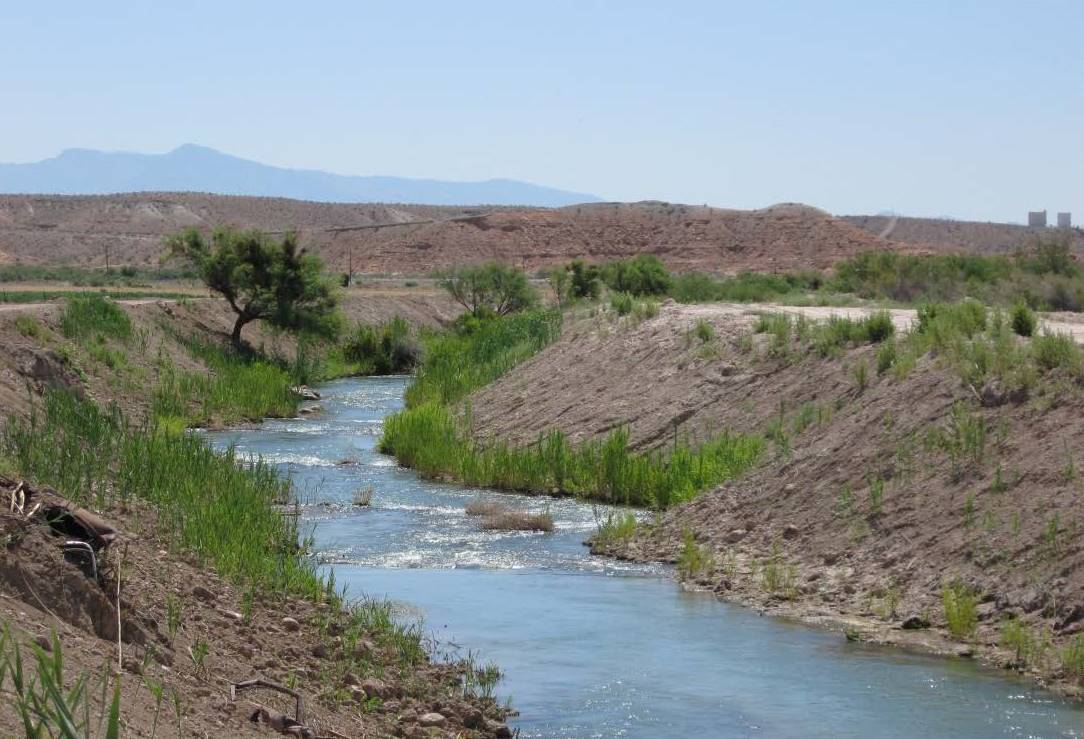
The Muddy River Ecosystem Recovery project is designed to recovery the endemic Moapa dace (Moapa coriacea) and other native biodiversity dependent upon the Muddy River in southern Nevada. It is a basin wide recovery effort focused primarily on upstream portions of the river (springheads, springbrooks), but extending downstream nearly 30 km to Lake Mead.
The Muddy River Ecosystem Recovery project is designed to recovery the endemic Moapa dace (Moapa coriacea) and other native biodiversity dependent upon the Muddy River in southern Nevada. It is a basin wide recovery effort focused primarily on upstream portions of the river (springheads, springbrooks), but extending downstream nearly 30 km to Lake Mead. Moapa dace is a unique genus of endangered fish with the highest recovery priority possible (recovery priority 1c). Other native species that benefit from this recovery include the Virgin River chub (Gila seminuda), which is an endangered species in the Virgin River (of which the Muddy River is a tributary), and three mollusks (Pyrgulopsis avernalis, P. carinifera, Tryonia clathrata) that were petitioned for listing under the Endangered Species Act and found to warrant further consideration for listing. The Muddy River also supports endangered southwestern willow flycatcher (Empidonax traillii extimus) and many other wildlife species.
Beyond the recovery goals detailed above, this project also builds trust among its many partners which helps facilitate other recovery efforts in southern Nevada and the southwest generally. As importantly, this project demonstrates the power of cooperation in achieving effective conservation progress at local and watershed scales.
The Muddy River is a major river in southern Nevada centered about 30 miles NE of Las Vegas (population of about 2 million). Many places of human interest exist along and near the Muddy River, including Moapa Valley National Wildlife Refuge and Warm Springs Natural Area at its headwaters, the towns of Moapa, Logandale, and Overton downstream, and many scenic destinations such as Lake Mead National Recreation Area, Valley of Fire State Park, and several established and proposed wilderness areas.
Although partners in the Muddy River ecosystem recovery project bring different values, motivations, and perspectives to the effort, their focus on the common goal of recovering the Muddy River helps to create consensus and support. Even a local newspaper (the Moapa Valley Progress) has consistently reported in a balanced fashion that helps create community interest and a sense of benefit, particularly as recovery progress has recently accelerated.
Two projects at the Muddy River have been funded at least in part by the Desert Fish Habitat Partnership: Apcar Culvert Replacement and Muddy River Stream Bank Habitat Rehabilitation. The Apcar project was completed in 2013 and now connects vital breeding areas (upstream) with holding areas (downstream) for Moapa dace. The Stream Bank Habitat Rehabilitation project was developed by the Moapa Band of Paiutes (a sovereign tribe) and is a 2014 DFHP project.
Currently, a large portion of the lower reaches of the Muddy River and the associated riparian area are degraded due to historical river dredging, overgrazing and streambed trampling by cattle. In addition, invasion of Salt Cedar (Tamarisk) and Phragmites has replaced native cottonwood and willow vegetation. Implementing a stream bank stabilization project and habitat improvement plan along the Muddy River will result in improved fisheries habitat for the Virgin River chub and Moapa speckled dace. The Muddy River Stream Bank Habitat Rehabilitation project will entail removal of invasive species (Tamarisk and Phragmites) and stream bank restoration utilizing natural stream bank stabilization techniques (bioengineering techniques). This project is scheduled to be completed in May 2015. Outreach for this project will begin in March 2015. The Moapa Band of Paiutes will begin site tours and prepare brochures and training material for Tribal members and the public on the importance of the Muddy River and its critical fisheries habitat.
The Muddy River recovery effort received major national funding (>$800K) in early 2014 for chemical eradication of exotic fish plus some habitat restoration. This work should foster substantial recovery over the next 3 years (the implementation period) and beyond. Hence, the Muddy River will definitely be a “Water to Watch” this coming year and for the next several years to follow.
Partners:
The partnership detailed below involves national, state, and local jurisdictions, plus many other entities that cooperate to recover the Muddy River ecosystem. While local attitudes about conservation are often mixed, successes in recent years at reversing the decline of Moapa dace plus other accomplishments have helped strengthen this partnership. Partners include several programs in the U.S. Fish and Wildlife Service (Moapa Valley National Wildlife Refuge, Ecological Services, Fisheries), Desert Fish Habitat Partnership, Nevada Department of Wildlife, U.S. Bureau of Land Management, Southern Nevada Water Authority, Moapa Valley Water District, Nevada Energy, Moapa Band of Paiutes, Clark County, The Nature Conservancy, Coyote Springs Investments LLC (a development firm), U.S. Geological Survey, U.S. Environmental Protection Agency, Natural Resource Conservation Service, university academics, and private landowners.
Moapa Valley National Wildlife Refuge (MVNWR) and Warm Springs Natural Area (WSNA) have volunteer programs focused on helping the public appreciate and understand the natural spring-fed ecosystems that merge to form the Muddy River ecosystem. Nevada Department of Wildlife also has a volunteer program that has involved Muddy River work on an intermittent basis. Several Eagle Scout projects were focused at WSNA. And the formal volunteer group Friends of the Desert National Wildlife Refuge offers public outreach events at MVNWR each year.
